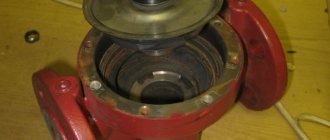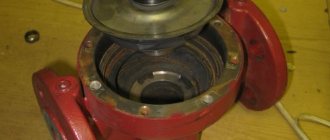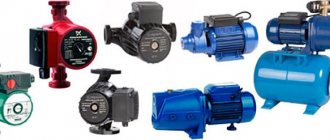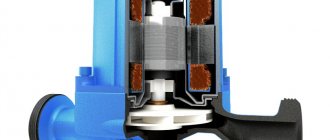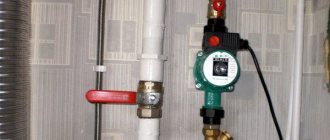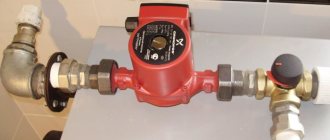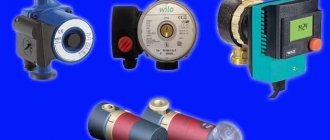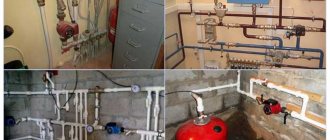The heart of any heating system is the circulation pump, which is responsible for the forced movement of water in the system. To minimize energy costs and at the same time create comfortable temperature conditions in a living room, buy Wilo pumps.
Ensuring their efficient and reliable operation and extending their service life occurs through compliance with operating rules and timely maintenance. If the owner ignores these requirements, equipment malfunctions will inevitably occur. Their elimination when the warranty period has expired is often done by hand.
1 Design and technical features
Vilo pumps significantly increase the efficiency of the heating system and the heat transfer of the coolant. Their use makes it possible to use pipes with a smaller cross-section when assembling the main line, which will reduce fuel consumption, reduce carbon dioxide emissions, and allow for savings to be achieved without loss of quality of operation. This is achieved through a properly thought out and designed design designed for continuous operation.
Checking the rotor water jacket
The Wilo pump consumes no more than 250 W per day, operation is silent, since there is no fan or similar technical elements that produce noise. There are two types of circulation equipment on sale - with a dry and wet rotor. The latter are used when installing heating systems, usually inside small buildings. The difference also lies in the power and volume of the pumped medium. The weakest model can make the heating system more efficient over an area of 200 sq.m.
The powerful one is designed for heating buildings with an area of up to 1000 sq.m. Both units have the most simplified design and small dimensions. Technical characteristics regarding pressure height allow you to lift water from 8 meters at a flow rate of 5 m3/h.
Distinctive features are the strength and corrosion resistance of the Wilo pump material. For example, the body is cast from cast iron, the shaft located inside it is made of stainless steel. Its fastening is possible thanks to graphite bearings. The water supply speed is equipped with three-stage adjustment.
The permissible coolant temperature in household products should not exceed +110° C; for industrial products the temperature limit is increased. As for the operating pressure, units used in everyday life can withstand 10 Bar, and industrial ones - 16.
The operation of the system is controlled automatically. Some models of circulators have a thermostat. The functions of the mechanism are displayed on the liquid crystal display. You can also control the shaft rotation speed by manual switching. Connecting the device is simple and quick, which is facilitated by the presence of springy terminals. Voltage surges are not a problem for the pump, since the motor and rotor have a multi-stage protection system.
1.1 Operating requirements and prevention
To avoid premature repair of Wilo pumps, the manufacturer urges you to adhere to the following:
- Do not allow the device to idle when there is no water in the system. Dry running destroys the insulation, disrupts the cooling of the electric motor and damages all equipment.
- The operating mode is set strictly in accordance with the maximum and minimum capabilities of a particular model.
- When the pump is on, the coolant flow must not be blocked.
Disassembling the circulation pump
If these rules are observed, the pump will be characterized by maintaining a stable pressure, and the sound produced during operation will be uniform and quiet. Most pumps do not require repairs for 5 years from the moment they are put into operation. It is required only when the main components are completely worn out or force majeure circumstances cause the device to fail.
Prevention is another type of periodic measures, the implementation of which insures the pump and its elements from premature breakdowns. In this case, simple maintenance is carried out manually, without the intervention of a specialist. To do this, you should visually inspect the external and internal parts of the unit at least 3-4 times annually and clean it if necessary.
Practice shows that cleaning becomes mandatory after 2-3 years of operation. The quality of the coolant and the general conditions under which the heating system operates affect the cleaning procedures.
For prevention, you need to prepare a Phillips and flathead screwdriver, a spanner wrench, and a cleaning brush. Inspection requires disassembly, during which you will find the main components of the hydraulic structure: housing, impeller, motor shaft, rotor, terminal box, propeller and the engine itself. Pay attention to the following nuances:
- grounding performance;
- absence of leaks at joints;
- pressure value in accordance with technical standards;
- absence of vibration and extraneous sounds (knocking, clanging);
- condition of the case. It must be clean and dry;
- the pump should not get very hot;
- the amount of lubricant on bearings, flanges and moving parts must be sufficient;
Also make sure that the terminal box cables are free of moisture, that they are securely fastened, that the gaskets provide a seal, and that the connections to the main line are strong. Before dismantling the device, water is drained from the system, the area where it enters is blocked, after which the pump is removed.
Rules for installing and connecting the circulation pump
The 6 bolts connecting the shell of the pump part and the motor housing are unscrewed with a spanner. Once the shell is removed, the drainage holes will be accessible. The impeller remains on the engine rotor. Using a narrow flat-type screwdriver, pry off the jacket that serves as the impeller and engine compartment. The actions taken will remove the rotor shaft and impeller from the stator cup.
At this stage, the inner surface of the shell, rotor and impeller are cleaned of dirt deposits or scale. A stiff polymer brush and a small amount of cleaning agent with hydrochloric acid will help with this. It would be a good idea to check all seals and gaskets for cracks; if found, replace them with new ones.
How to carry out regular pump maintenance?
The pump, like any other mechanism, needs periodic maintenance. Here's what the owner of such a device needs to do:
- In the warm season, when the circulation pump remains idle, turn it on for 15 minutes every month. Of course, the device should not run idle: if the heating system is currently empty (many people drain the coolant for the summer), you just need to pump water from one container to another, connecting a pump to them using hoses. This measure will prevent oxidation of the shaft surface, which could result in blocking. And thanks to such “training,” the bearing will last longer.
- During the heating season, periodically pay attention to how the pump works. Are there any noises, vibrations or other signs of developing defects? Does the unit maintain the required system pressure? Is the engine getting too hot? A malfunction detected at an early stage is much easier to fix than one that has already been severely neglected.
- If a coarse filter is installed in front of the pump, it must be periodically checked for contamination, even if the system uses prepared coolant (the filter can become clogged with rust washed off by the working medium from the pipe walls).
- It is also necessary to check from time to time whether the amount of lubricant is sufficient in those places where it is provided.
During downtime, the gaskets in the pipes should be coated with a preservative lubricant, which will prevent them from drying out.
Make sure that the temperature of the coolant in the place where the circulation pump is installed (usually it is installed on the “return” in front of the boiler) does not exceed the permissible value.
The limit value is indicated in the device passport. For most models, the optimal temperature value is 65 degrees.
Mechanical repair
All other parts that are not listed in the section: “Electrical repair” refer to mechanical components. If vibration or noise occurs in a running pump, to determine the source of its occurrence it is necessary:
- Stop the boiler smoothly.
- Remove the front panel of the housing and lower the control unit.
- Close the cold water, supply and return taps.
- Drain water from the boiler system through the drain valve.
- Unscrew the pump air vent lock to completely drain the water from the system. After all the fluid has been drained, tighten the lock until it stops.
- Remove the terminal with the starting capacitor.
- Unscrew the fastening screws and remove the motor-turbine unit.
- Inspect the bearings, impeller, and pump cavity for oxidation, contamination, foreign objects, and damage. If there is wear on the bearings or the motor shaft rotates with force, then they need to be replaced with others, for example, fluoroplastic ones. All dirt from the turbine, internal compartments of the housing, and sealing rubber should be removed.
- Place the repaired mechanism in place and secure it.
- Insert the terminal with the capacitor.
- Open the return, supply and cold water taps.
- Using the make-up tap, check the pump for leaks; if it does not leak, then add coolant to the system up to 1.2 bar.
- Start the pump in circulation mode and check its condition.
- If the results are positive, set the heating circuit temperature control knob to the required position.
The service life of the Wilo circulation pump and other boiler components can be extended if full maintenance is carried out before each heating season.
How can you eliminate typical circulation faults?
Let's see exactly how they can be expressed and what the user should do in a given situation.
So, the main malfunctions of circulation pumps and ways to eliminate them.
The pump motor cannot be started, but no humming or other “electrical” sounds can be heard.
In this case, the first suspect is the fuse, if your model has one, of course. It reacts sensitively to power surges, which, alas, are not uncommon in suburban areas, and at the slightest threat to the engine it melts, opening the electrical circuit. After replacing the fuse, the pump will return to operating condition.
If the fuse is intact, you should “ring” the power cord and electrical wiring, and also check the condition of the fuse or circuit breaker in the junction box. Perhaps it or some section of the wire needs to be replaced.
If everything is in order with the wiring, the electric motor winding may have burned out. Its condition is checked by measuring the resistance (using a multimeter). When connected to the contacts of the working winding, the device should show 10 - 15 Ohms.
Some pumps, in addition to the working one, also have a starting winding. Its resistance should be 35 - 40 Ohms.
If the meter display shows “infinity” instead of the indicated numbers, then the winding under test has burned out. If the multimeter readings, on the contrary, tend to zero, then there is an interturn short circuit. In this case, when you try to turn on the pump, the fuses in the panel will trip.
The cause of the pump “strike” may also be a breakdown of the non-polar capacitor present in the starting winding circuit. In good condition, it has a capacity ranging from 10 to 40 μF. If the meter readings differ from normal, the part must be replaced.
You can undertake electrical repairs yourself if you have sufficient experience in this matter. In most cases, you have to trust specialists.
The pump hums, but the shaft with the impeller does not rotate
In such a situation, the pump must be turned off, otherwise the motor winding may burn out. There may be several reasons for such a breakdown:
- As already mentioned, the shaft may become stuck due to prolonged inactivity. Also, an impeller that does not work for a long time can stick to the housing. In such a situation, you need to disassemble the pump and force the shaft to rotate. To allow the user to do this, there is a notch on the shaft that can be grabbed with a screwdriver. If you were unable to find it, disassemble the discharge mechanism and turn the shaft, holding the impeller itself.
- The impeller may become stuck due to a foreign object entering the chamber. By removing it, you will resume system operation.
Electrical repair
The electrical part of the pump includes the following components:
- inductor;
- starting capacitor;
- connecting wires;
- control terminal.
If the stator winding breaks down, the pump becomes unrepairable; all other components can be repaired or replaced. To analyze the condition of electrical parts, you will need an ohmmeter.
Photo of the circulation pump Wilo MTSL 15/5 HE – 2.
Main symptoms of malfunction
If the boiler display shows an error code corresponding to a water circulation problem, and it is not reset, the problem may be hidden in the electronic part of the device.
Circulation pump with cover removed.
To identify the problem you must:
- Turn off the heating mode in the boiler, and after stopping all components, turn off the power (soft stop).
- Open the front panel of the case.
- If the pump is covered with a large layer of dust, clean its surface.
- Using the information in the diagram, remove the control terminals and remove the terminal with the capacitor.
- Visually examine the condition of the pump contacts and terminals; they should be free of oxides, burnouts and mechanical damage.
- Using a tester in diode testing mode, determine the integrity of the connecting wires that go from the control board to the pump.
- Use an ohmmeter to determine the resistance of the inductors. On a working device, the instrument readings on the contacts will correspond to the following values:
- No. 1, 4 – 150 – 160 Ohm;
- No. 1, 6 – 290 – 300 Ohm;
- No. 2, 3 - 0 (contacts connected together);
- No. 3, 5 – 220 -230 Ohm;
- No. 4, 6 – 150 – 160 Ohm.
- The device will be considered faulty if the ohmmeter reading on any of the above pair of marks is 1 (winding wire break) or 0 (short circuit, except for contacts 2,3).
- Check the condition of the starting capacitor. To do this, switch the tester regulator to the 20 microfarad capacity test mode. Connect the probes of the device to the terminals of the capacitor and determine its capacitance. It should match the nominal ± 10%. Loss of capacity leads to a decrease in pump performance; it will emit an uncharacteristic hum.
Electrical diagram of the pump Wilo MTSL 15/5 HE – 2.
Measuring the resistance of the circulation pump windings.
How to prepare circulation pumps for the winter heating season?
In anticipation of cold weather, it is necessary to bring the heating system into a state of combat readiness. Regarding the circulation pump, you need to do the following:
- Check the tightness of the connections between the pump pipes and the pipelines. If a leak is detected, the nut or coupling must be slightly tightened. If this does not help, you will have to replace the cracked gasket or seal. If you lack experience, it is better to use fluoroplastic (FUM tape) or Tangit Unilock flax thread to seal pipe threaded connections.
- If there is a strainer in front of the pump, check its condition and wash it if necessary.
- Make sure there is sufficient lubricant in the motor and bearings.
- It would not be superfluous to use a multimeter to measure the voltage in the socket through which the pump will be connected to the network. There are known cases when electricians in rural settlements supplied 3-phase (380 volts) voltage to houses instead of 2-phase. The parameters of normal, 2-phase voltage may also differ from the norm. If the multimeter shows, for example, 235 V or 205 V instead of the required 220, you need to contact the appropriate service of the energy company.
If you have no complaints about the quality of the power supply and no coolant leaks have been detected, you should test run the pump and let it run for a while. The absence of the above symptoms will indicate that the device is ready for the new heating season.
Since forced circulation is more effective than natural circulation, circulation pumps are becoming increasingly in demand. Circulation pump for heating systems - installation procedure and selection features, read carefully.
We will examine the positive and negative aspects of the Leningradka heating system in the next topic.
Video on the topic
Do-it-yourself circulation pump repair - step-by-step instructions
DIY circulation pump repair
Circulation pumping devices are very popular among owners of private houses and summer residents. The range of pumping equipment is quite wide, but the general principles of the device are the same. Such equipment can stop due to minor breakdowns, for example: the pressure switch of the pumping station does not work, what should I do? Should I take my broken pump to a service center? This costs money, and in many regions there are simply no service companies. Therefore, an economical home owner should know how to install a water pump with his own hands.
Circulation pump device
To understand how to independently disassemble, maintain, and repair a circulation pump, you need to know its structure. Such equipment is arranged as follows:
- all components and mechanisms are housed in a housing made of steel (mostly stainless), aluminum and other alloys;
- An electric motor with a rotor is located inside the housing;
- a wheel with wings is installed on the rotor - an impeller, which is usually made from technical polymers.
Circulation pump device
Operating principle of circulation pumps
After turning on the electrical circuit, the engine begins to rotate the rotor with the impeller mounted on it. Liquid is supplied to the central part of the pump. The blades rotate and throw water or other coolant towards the outside of the housing. Under the influence of centrifugal forces, the liquid moves and enters the outlet pipe of the pump.
Circulation pump in the heating system
Types of circulation pumps
There are currently two main types of circulation pump devices on the market.
- “Wet type” - in such equipment the rotor is completely immersed in the pumped liquid. A significant advantage of this configuration is the cooling of rubbing and heating parts by contact with liquid. Such equipment is quieter and costs less. When installing it, it is necessary to maintain the housing position specified by the manufacturer (usually horizontal), since the rotor must be completely immersed in the liquid. Also, “wet-type” devices are easier to maintain, but are very sensitive to the lack of liquid in the system (operating “dry” can quickly damage the pump).
- “Dry type” - in such devices, the pump motor is placed in a separate compartment or module, and torque is transmitted to the rotor through a drive device (clutch). Dry type pumps are more efficient, but also have a more complex design. A “dry” pump can operate without damage even in the absence of fluid in the system, but such operation will lead to increased wear of the drive.
Also, circulation pumps can be divided into types according to the method of execution:
- monoblock;
- console, consisting of separate blocks.
Pump with cover removed
You may be interested in information on how to make a heat pump with your own hands.
How to properly operate a circulation pump
In order to avoid having to disassemble and repair your equipment once again, it must be used correctly.
- Never turn on the pumping device without liquid in the heating pipes.
- Keep the volume of water pumped within operating specifications. Exceeding or decreasing the volume of pumped water relative to the indicators specified in the technical data sheet is unacceptable. If the pump is designed to pump from 5 to 100 liters of water per hour, pumping 3 or 103 liters of water will wear it out a lot.
- If your pump is idle for a long time, then turn it on for about a quarter of an hour once a month. This will help prevent oxidation of moving parts and subsequent damage.
- Maintain the temperature in water supply pipes no more than 65 degrees. If the temperature of the coolant exceeds, sediment can damage the moving parts of the pumping device. Water temperatures above 65 degrees (for example, 70-80°C) contribute to rapid wear of equipment.
To come in
Already registered? Sign in here.
There are currently 0 users on the page
There are no users viewing this page.
Modern circulation pumps require virtually no maintenance, and if a heating circulation pump needs to be repaired, it is better to entrust this task to a specialist from the service center. However, in order to prevent equipment breakdown, you can take some measures that will help prevent such an unpleasant event.
How to carry out regular pump maintenance?
From time to time, preferably at least once a month, it is necessary to carry out an external inspection and check the quality operation of your circulation pump device.
Pump design option
- Turn on the pump and in operating mode, check for any extraneous noise or excessive vibration.
- Check the coolant pressure supplied by the pump. It must correspond to the indicators stated in the technical data sheet.
- Make sure that the electric motor of the device does not become overheated.
- Check the presence of grease on the threaded flanges and, if necessary, restore it.
- Make sure there is a ground connection between the pump housing and the appropriate terminal.
- Inspect the pump from all sides and make sure there are no leaks. Typically, such vulnerable points are the interface between the pipeline and the housing of the pumping device. Check the tightening level of the bolts and the normal condition of the gaskets.
- Inspect the terminal box. All wires must be securely fixed. The presence of moisture in the unit is unacceptable.
How can you eliminate typical circulation pump malfunctions?
There are a number of typical faults in circulation pumping devices that you can fix yourself. Each block will describe the symptoms of a malfunction, its causes and steps to do it yourself.
The pump is humming, there is no rotation
The cause may be oxidation of the motor shaft during prolonged inactivity of the pump. Troubleshooting instructions.
- Turn off the power to the equipment.
- We remove water from the pump and pipelines adjacent to it.
- Remove the screws securing the housing and the electric motor.
- We dismantle the electric motor complete with rotor.
- We turn the rotor by hand or with a screwdriver, resting against the working notch.
The next reason for such a malfunction may be the ingress of foreign objects.
- Turn off the power to the equipment.
- We remove water from the pump and pipelines.
- Remove the screws securing the housing and the electric motor.
- We remove the foreign object.
- We protect the pump inlet pipe with a strainer.
The lack of rotation can also be caused by a lack of power supply. To do this, we use a tester to check the presence of power at the terminals in the box and the correct connection of the electrical wires.
The pump does not hum or rotate
The main cause of such a malfunction may be a lack of power supply or insufficient voltage in the network. To eliminate it, you need to use a tester to check the voltage at the terminals and, if necessary, whether the device is connected correctly to the power supply.
Many electric pumps are equipped with a fuse. During power surges, it burns out and requires replacement.
The pump starts working, but stops after a while
The cause of this malfunction may be the deposition of limescale between the stator and the rotating rotor. The malfunction can be eliminated by dismantling the electric motor and cleaning it of limestone deposits.
The pump makes a lot of noise when turned on
The cause of this malfunction may be the presence of air in the heating system pipeline. To eliminate it, you need to bleed the air from the pipes. To automatically release air, it is recommended to install an automatic unit in the upper segment of the pipeline.
If a sharp noise is accompanied by increased vibration, it is recommended to increase the pressure at the inlet to the pumping device. Insufficient pressure can be compensated by increasing the coolant level in the system.
The pump vibrates a lot
The cause of such a malfunction is usually severe wear of the bearing that ensures the rotation of the impeller. The malfunction is eliminated by replacing the worn bearing.
What to do if the pump produces insufficient pressure?
The cause of such a defect may be the wrong direction of rotation of the wheel with blades. The cause of this phenomenon is usually an incorrectly connected phase when connecting three-phase equipment.
Also, a decrease in pressure can be caused by increased viscosity of the coolant, then the impeller encounters too much resistance. To eliminate it, it is necessary to clean the filter on the inlet pipe from deposits, check the cross-section of the incoming pipeline and set the necessary pump adjustment parameters.
What to do if the pump stops after starting?
Most likely, the cause of such a malfunction may be incorrect connection of the wires according to the phases in the terminal box. The fuse on your pump may not be tight enough. Remove it and clean the clamps.
Basic problems and methods for resolving them
In cases where vibration appears during operation of the device, extraneous noise occurs, or the pressure in the system changes, you should determine the cause and, if possible, troubleshoot the problem yourself.
When turned on, the pump hums, but the shaft does not rotate:
- The shaft jammed due to prolonged downtime. Remove the protective cap on the motor housing and rotate the shaft using a flat-head screwdriver;
- if foreign objects get in, disassemble the pump and clean the impeller, after which replacing the cleaning filter, which is installed in front of the device;
- problems with power supply (insufficient voltage in the network).
When turned on, the device does not work:
- there is no voltage in the network. Electrical wiring and protective automation are checked;
- The fuse has blown. Replaced with a new one.
Automatic shutdown of the device after a short period of operation:
Rules for installing and connecting the circulation pump
- accumulation of limescale in the stator cup. The glass and rotor of the electric motor are cleaned.
How to prepare circulation pumps for the winter heating season
In order for your heating pump to operate smoothly throughout the cold season, routine maintenance must be carried out before the start of the heating season.
- Check that the pump is connected correctly to the heating piping network. Pumping equipment must be installed in a place in the irrigation network where there is minimal possibility of air pockets forming. It is rational to place it on the return line, in front of the heating boiler.
- Before starting operation, make sure that all connecting elements of the network have maintained their tightness. To prevent the gasket from drying out, the inlet and outlet pipes are coated with a preservative lubricant during breaks in operation.
- Check the condition of the filter in front of the pump inlet. Replace or clean it if necessary.
- Check that the device is properly connected to the power supply. Not only the density of the contacts on the terminal box and the serviceability of the fuse are checked, but also the correct connection of the phases and the operating voltage in the network. The best way to check these characteristics is with a tester.
- Before starting to operate the heating circulation pump, be sure to carry out a test run, which should confirm the complete tightness of the system and the serviceability of all its components and equipment.
Sectional view of the pump
How to dismantle and disassemble a circulation pump
If, during a test run of the equipment, shortcomings of the pumping device are identified that cannot be eliminated without dismantling and disassembling it, you will have to perform the following operations.
- At the preparatory stage, the pumping equipment is de-energized. When installing the pump, a bypass is built into the pipeline system - a heating bypass pipe. During normal operation it closes. During long-term repairs, it may be necessary to connect an additional pumping device to the system.
- Unscrew the shut-off valves securing the pump and remove it.
Dismantling the pump before repair is especially necessary if your heating pipelines are made of metal-plastic. Repairs “on the fly” can damage such pipes.
Disassembling the circulation pump
Pumping equipment diagram
When seriously repairing pumping equipment, it is necessary not only to dismantle it, but also to disassemble it. It is performed in the following sequence.
- The circulation pump cover is fixed to the housing using bolts. These can be screws for a Phillips screwdriver or hexagon. During operation, the bolts may “stick”. This problem can be solved with the help of specialized aerosols, also called “liquid key”. It is applied to the bolt and after a few minutes it can be easily unscrewed.
- Remove the cover. In front of us is a rotor with a rotor with a wheel with blades attached to it. Usually it is held on by clamps or bolts. Remove it and you will gain access to the “insides” of the pumping equipment.
- Inspect the pump, determine the faulty unit and replace it.
Useful tips
Self-repair of circulation pumps should be carried out only after the end of the warranty period or if it is impossible to obtain qualified technical assistance. A number of pump components are quite difficult to find on the open market. This is usually caused by the manufacturers' trade policies, so be prepared for the fact that in some cases it is cheaper to purchase new equipment rather than repair broken equipment.
Gland pump design
To learn more about circulation pump repair technologies, watch the training video.
Latest Arrivals
E.syboxmini – the world's most compact electronic pressure booster system! Happy Independence Day Ukraine! EVOTRON circulation pumps with a “wet” rotor and frequency regulation The Vulver company at the Aqua-Therm Kiev 2015 exhibition GENIX - a new pressure station for collecting and automatically pumping fecal wastewater Submersible 4″ electric motor DAB Centrifugal pump DAB K-HA Greetings from Novy Rok! Help the guys who are defending our Motherland! Hydraulic accumulators GWS ATTENTION, FAKE! The season is in full swing! Autumn offer New series of DAB filters for forward filtration Vertical centrifugal pumps of the NKV 32, NKV 45 series Representatives of the Wulver company visited the 18th international exhibition on water treatment, water purification, recycling and waste disposal, IFAT 2014. Horizontal frequency-controlled pump KDNE MCE/P Horizon nal frequency-controlled pump KDNE MSE/S Cavitation is a risk factor Horizontal frequency-regulated pump KE Dab monoblock frequency-controlled pumps NKM-GE/NKP-GE MSE/S Centrifugal pumps with built-in pre-filter - EUROPRO EVOPLUS SAN - glandless circulation pump and electronic control for the hot water system ERHARD ROCO Premium - innovative butterfly valve EVOPLUS D - double glandless circulation pump with electronic control
DABDAB sewer pumpsAqua-Therm KievDomestic pumping stationsValve valves with a rubber wedgeSewer pumpsPumping stationCirculation pumps DABdomestic pumping stationwater supplychoice of a pumping stationchoice of a well pumpwhere to buy a water pumpdeep pumps for wellswhy do you need a check valvehow to choose a circulation pumpbuy a pump for a wellbuy dab pumpsbuy a check valvebuy a circus lation pumpDab pumppump for seweragepump for well buypumping station Dabpumping equipment DABpumping stations DABpumping stations for increasing pressuredab pumps Ukrainepumps for heating systemswaste water treatmentsubmersible pumps dabsubmersible pumps for wellssubmersible well pumpsselection of a pumping stationsale of pumping equipmentsale of pumping equipment dabsale of pumping equipment Ukraineself-priming pumps dabwell pumps dabpressure increasing stationspressure increasing installation for the homesewage pumpcentrifugal pumps DABcentrifugal pumps for wells
